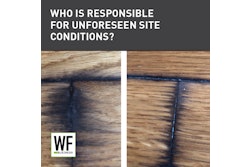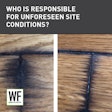
Has a customer ever asked you to install something even after you explained it was a bad idea? In the wood flooring business, it's almost a certainty that at some point you'll be pressured by a homeowner or GC to do something you know you shouldn't. Under this pressure, you might turn to a waiver as an option that will make the customer happy and protect you from liability. But if you have the customer sign a waiver acknowledging that you warned him or her of the risks and aren't liable for any future issues with the wood floor, is the signed waiver really enforceable? Many contractors have stories about being held responsible by a judge— despite having a waiver. In those cases the judges took the waivers as an admission of guilt—suggesting the pro knew better but did the job incorrectly anyway.
In my experience, however, waivers and disclaimers are enforceable if drafted properly, and I have indeed enforced them many times for my clients. However, in some states, certain construction warranties may not be waived. Also, in some cases there is still an open question about the exact cause of the issues with the wood floor and whether those issues were related to the risky procedure detailed in the waiver. As a contractor, you need to protect yourself by being familiar with the laws and scenarios that can arise. Let's look at some examples.
Client finds wiggle room in acclimation dispute
A flooring contractor advised a customer that a certain wood was not suitable for the local climate and should not be installed. The customer insisted on using the wood anyway. The wood flooring contractor required the customer to sign a waiver stating that the customer was choosing to install the flooring against the contractor's advice and that the contractor was not responsible for future problems with the flooring.
As expected, issues with the floor later developed, and the customer demanded that the contractor fix the problems. Naturally, the contractor pointed to the signed waiver. Case closed, right?
Not quite. The customer argued that the species of wood should have worked in that climate, but the contractor had 1) failed to allow the wood to sit for the proper amount of time and acclimate before installing it and 2) failed to follow the manufacturer's installation guidelines. The customer even found another flooring contractor to give an opinion supporting these assertions.
The contractor who installed the floor denied that any of this was true, but factual questions remained. Despite the signed waiver, the case was not a "slam dunk" for the contractor. While a court would likely have ruled for the contractor, he did not want to spend the time and money to find out, and eventually he agreed to pull out and replace the flooring if the customer paid for the new materials.
Before that second installation, the contractor required the customer to sign an even stronger waiver/settlement agreement stating that the customer was waiving all claims of any kind, even if the floor failed again and even if it were the contractor's fault.
This case goes to show that even with a signed waiver in hand, customers can still create arguments and cause trouble to get what they want. In some cases, it is not cost-efficient to litigate an issue, and the path of least resistance (and least cost) is to contribute to the solution even if the wood flooring contractor was not at fault. Contractors must also think about the potential damage to their reputation from a failed job, even if it was an issue they had warned the customer about.
New cabin owners face properly drafted waiver
In another case, a flooring contractor was asked to install an exotic species of wood in a cabin in northern Minnesota. The contractor explained this was a bad idea, but the customer (who lived in Florida) insisted on using this wood because of its unique appearance and how it complemented the rest of the cabin's décor. The customer signed a professionally drafted waiver (full disclosure: mine) but shortly after the floor was installed, the customer sold the cabin. As expected, the flooring did not hold up well, and about 8 months after it was installed the new owners complained to the flooring contractor. They demanded he come out and look at the floor and tell them what he planned to do about it. He sent them a copy of the signed waiver. He never heard from them again.
If drafted properly, a signed waiver or disclaimer should be enforceable and should also serve as a significant deterrent against a customer making a claim later. If the customer signed a document essentially stating "I know you are telling me not to, but please install this flooring anyway," they will likely think long and hard before pursuing a claim against the contractor if there are issues later. Just be sure your waiver has been carefully reviewed by an attorney with experience in construction law in your state.
You can review and download a sample of a Flooring Release document I've used here.
Disclaimer:
Articles and forms posted by Blake R. Nelson and Hellmuth & Johnson, PLLC are for informational purposes only and not for the purpose of providing legal advice. You should contact an attorney to obtain advice with respect to any particular issue or problem. Use of and access to any of the articles or forms found on this site do not create an attorney-client relationship between Blake R. Nelson or Hellmuth & Johnson, PLLC and the user or browser.

































